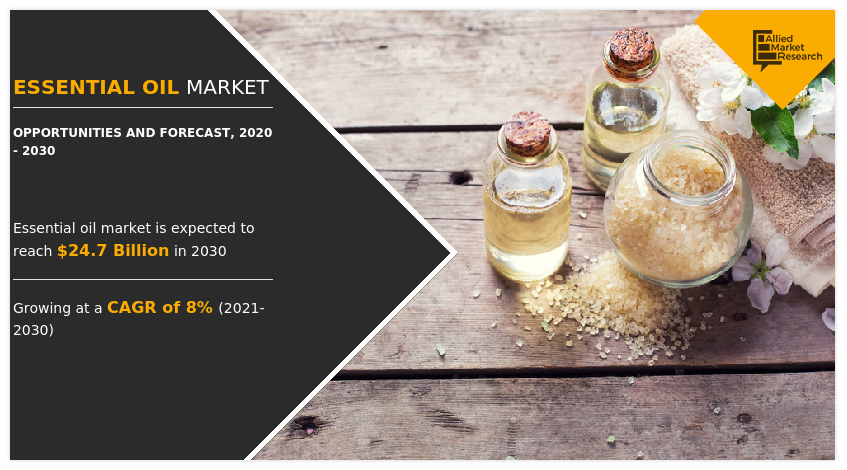According to a new report published by Allied Market Research, titled, “Essential oils Market,” The essential oils market was valued at $10,886.80 million in 2020, and is estimated to reach $24,721.60 million by 2030, growing at a CAGR of 8% from 2021 to 2030.
The orange segment was the highest contributor, with $4.3 billion in 2020, and is estimated to reach $10.9 billion by 2030, at a CAGR of 9.2% during the forecast period. Essential oils are generally extracted by distillation process, often by using steam.
Other processes used in the production of essential oils are expression, solvent extraction, absolute oil extraction, cold pressing, and resin tapping. Essential oils find usage in perfumes, cosmetics, soaps, and various other products, for flavoring food & drink, and for adding scents to incense and household cleaning products. Essential oils are distinguished from the fatty vegetable oils, such as canola and sunflower, by the fact that they evaporate or volatize in contact with the air and usually possess a strong aroma.
Download Sample Report: https://www.alliedmarketresearch.com/request-sample/1412
These products are complex mixtures of organic chemicals, the nature and relative proportions of which are determined by the genetics of the plant species, environmental factors (e.g. climate), agricultural factors (e.g. soil conditions, nutrition, time and conditions of harvesting and methods of post-harvest handling), and manner of extraction. The chemicals present in essential oils may be classified as follows:
• Hydrocarbons of the general formula (C5H6) n-terpenes
• Oxygenated derivatives of these hydrocarbons
• Aromatic compounds having a benzenoid structure
• Compounds containing sulfur or nitrogen
In such a situation, using herbal products having no pesticides, chemicals, or processed additives and picking natural, herbal food to minimize risk of disease, illness, and disorders is the new trend. Many consumers are avoiding chemical ingredients in their food, health food, functional food, proteins, and nutraceutical products. Hence, demand for naturally sourced ingredients such as essential oils in nutraceuticals is increasing continuously.
For Purchase Enquiry: https://www.alliedmarketresearch.com/purchase-enquiry/1412
This demand is mainly increasing in developed regions of North America and Europe as consumers in this region are spending more on natural products as compared to consumers in other regions. Hence, Essential Oil Market Trendsof using natural ingredients in the nutraceutical industry in proving one of the major factors to propel the growth of the market.
The global Essential Oil Market Growth is studied across North America, Europe, Asia-Pacific, and LAMEA. Asia-Pacific led in terms of market share in 2020, and is projected to witness significant growth during the Essential Oil Market forecast period, owing to growing disposable income, extensive advertising and promotion, and large scale urbanization. China along with India and South East Asian countries is expected to witness increased demand for essential oils in the coming years.
The Essential Oil Market Size is studied on the basis of product, application and distribution channel. By product, the market is divided into orange, eucalyptus, cornmint, peppermint, citronella, lemon, lime, clove, spearmint, and others. By application, the Essential Oil Market Share is divided into food & beverages, medical, cleaning & home, spa & relaxation, and others. By distribution channel, the Essential Oil Market Analysis is studied across direct distribution, MLM distribution and retail distribution.
Buy Now: https://www.alliedmarketresearch.com/checkout-final/aae77caeb80cfd0bf0d9d0ad1944d169
The prominent players analyzed in Essential Oil Industry include doTERRA International, Biolandes, Sydney Essential Oils Co. Pty Ltd., Young Living Essential Oils, Farotti SRL, The Lebermuth Company, Essential Oils of New Zealand, H.Reynaude & Fils, Moksha Lifestyle Products, and West India Species, Inc.
KEY FINDINGS OF THE STUDY
By product, orange essential oil had the largest market share in 2020 and is further expected to grow with the highest CAGR during the Essential Oil Market forecast period.
By application, food & beverage is the most commonly consumed form of essential oils; however, the usage of essential oils in cleaning & home products is expected to rise in the future.
By distribution channel, the most common method of purchase of essential oils is via direct distribution channels while retail distribution channels are gaining more popularity for essential oils purchase.
By region, North America is the largest consumer of essential oils products; however, Asia-Pacific is expected to grow at the highest CAGR during the forecast period.
Similar Reports:
Global Tea Tree Oil Market Expected to Reach $59.5 Million by 2025
India Olive Oil Market Expected to Reach $127.5 Million by 2025
About Allied Market Research:
Allied Market Research (AMR) is a full-service market research and business-consulting wing of Allied Analytics LLP based in Portland, Oregon. Allied Market Research provides global enterprises as well as medium and small businesses with unmatched quality of “Market Research Reports” and “Business Intelligence Solutions.” AMR has a targeted view to provide business insights and consulting to assist its clients to make strategic business decisions and achieve sustainable growth in their respective market domains. AMR offers its services across 11 industry verticals including Life Sciences, Consumer Goods, Materials & Chemicals, Construction & Manufacturing, Food & Beverages, Energy & Power, Semiconductor & Electronics, Automotive & Transportation, ICT & Media, Aerospace & Defense, and BFSI.
We are in professional corporate relations with various companies and this helps us in digging out market data that helps us generate accurate research data tables and confirms utmost accuracy in our market forecasting. Each and every data presented in the reports published by us is extracted through primary interviews with top officials from leading companies of domain concerned. Our secondary data procurement methodology includes deep online and offline research and discussion with knowledgeable professionals and analysts in the industry.
